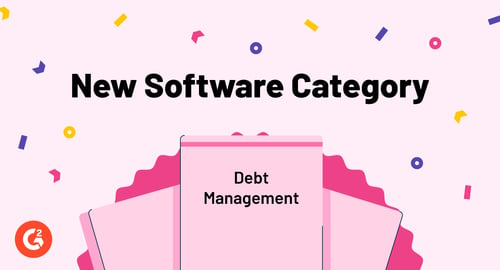Understanding finances is crucial for strategizing company transformation, structure planning, and assessing resources.
The financial services software space has been evolving rapidly in the last decade. As an industry leader adapting to trends and evolution, G2 aligns itself with fintech’s dynamic landscape by constantly updating its taxonomy.
G2’s new Debt Management Software category houses products that monitor debtors' and creditors' debt portfolios, track their covenants, schedule payments, and provide analytics and automated reporting features.
This space contains products that offer solutions to complex challenges and requirements, opening doors for new software in the fintech space. The goal is to assist businesses in tackling debt management hurdles and challenges while taking control of the debt portfolio seamlessly.
What is debt management software?
Debt management software helps businesses navigate every stage of debt engagement—due diligence, structuring and post-deal monitoring, streamlining the process of acquiring capital, ensuring compliance with credit agreements, and tracking and maintaining detailed records of transactions and payments. This facilitates strategic financial planning for businesses and financial institutions.
Debt maturity is a tradeoff between commitment to the debt and risk management. It’s a scheduled outline of the debtor's repayment obligations across different points in the process until complete repayment.
Similar to a maturity transformation, an entity raising debt borrows funds from institutional investors, banks, and other lenders for the purpose of working capital, re-lending or re-investing, and business operations.
Through this process, investors, creditors, managers, and debtors understand the timing of cash flow and the duration of the debt instruments, from inception to maturity, which aid risk assessment and strategize decisions regarding debt portfolio.
This necessitates a strategic tool for managing complex debt arrangements, ensuring strict adherence to covenants outlined in credit agreements, monitoring transactions, ensuring timely documentation, and navigating the repayment process to guarantee compliance and rule adherence.
Debt management software enables lenders and investors to align their investment strategies with their cash flow needs, risk tolerance, and investment horizons while considering short-term and long-term debts to optimize returns and manage liquidity and credit risk.
Tailored solutions for diverse clientele and debt types
Fintech companies primarily use this software, but it also caters to horizontal industries such as specialized financial companies (credit card firms, small business loan institutions, and so on), real estate firms, chemical companies, and others requiring heavy investment or operating capital.
Debt management software serves a variety of debts, including asset-backed debts and securitized and unsecuritized loans, which makes it an indispensable software for fintechs dealing with collateral-based lending.
Tip: Always evaluate the software's integration potential, customization options, scalability, security and compliance capabilities, and comprehensive reporting capacity that can provide analytics aligned with the business’s KPIs.
What does global corporate debt look like?
To understand corporate debt, we must analyze their types, i.e., corporate loans and bonds. The former acts similarly to personal loans, wherein a company borrows money from a bank or financial institution for a mutually agreed interest rate and terms.
Meanwhile, the latter is issued by a company as a financial instrument and sold to the creditor (a financial investor). The major difference is that bonds can be traded in the market, and their interest rates are lower than loans.
In the first quarter of 2023, the debt amassed by non-financial companies amounted to 97% of the global GDP. Furthermore, around 45% of this debt is held by companies in emerging markets (such as Argentina, Brazil, Hong Kong SAR, China, India, Korea, Russia, Singapore, and Saudi Arabia), which is continuously increasing.
Empowering financial success and mastering debt dynamics
G2 hosts a range of software categories, including loan, credit, and debt.
To analyze the necessity of creating a new category, we need to understand the similarities and differences between the existing categories, such as Accounting, Loan Servicing, Credits and Collections, and the new category—Debt Management.
Accounting (which also includes Accounts Receivable and Accounts Payable categories) and credit and collections software encompass payments and transactions between a company and its suppliers and service providers for the products and services delivered to the company.
This indicates the uniqueness of debt management software from accounting and credit and collections software due to its focused role in managing and optimizing debt-related transactions and relationships between borrowers and institutional investors.
Unlike loan servicing software, which streamlines the process of the loan life cycle, debt management software delves deeper into the lifecycle of debt of companies, institutions, and firms, managing the debt portfolio from inception through maturity.
It encompasses the due diligence, structuring, and post-deal monitoring phases of debt transactions, including debt analytics, which are features not inherently designed in the functionalities of loan servicing, accounting, or credit and collections software.
The way ahead
According to G2 data, the Accounting, Loan Servicing, and Credits and Collections categories have seen a large intake of more than 496 products in the past 4 years.
Especially from 2021 to 2023, we observe a consistent increase in the number of products added to G2, which also suggests a growing interest. With this development, it becomes clear that there is a sine qua non for G2 to be equipped for their accommodation.
We see debt management as a small space currently; however, with the global debt market rapidly growing, there is a strong demand for software that offers debt portfolio management. Therefore a potential boom and expansion in this space could be on the horizon.
Learn what fintech is all about and why it's the future of money.
Edited by Jigmee Bhutia


 by Samarth Bhat
by Samarth Bhat
 by Patrick Szakiel
by Patrick Szakiel
 by Patrick Szakiel
by Patrick Szakiel